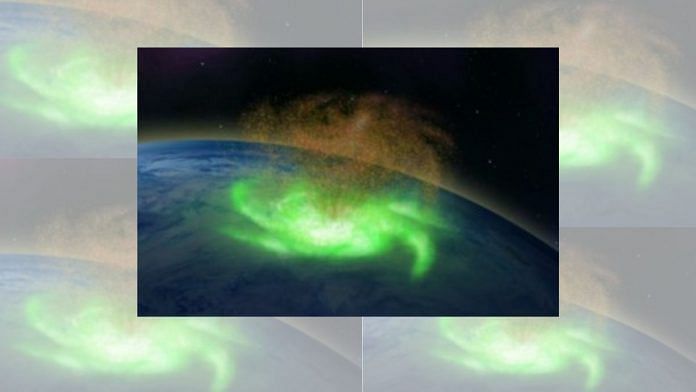Bengaluru: The first ever observation of a ‘space hurricane’ on Earth’s upper layers of atmosphere has been announced by scientists at the University of Reading, in collaboration with the Shandong University in China. The observations were first made in August of 2014 by satellites, but the data was revealed only recently through a retrospective analysis.
The findings showed a 1,000-km wide swirling plasma above the North Pole, spinning in a manner similar to hurricanes or cyclones formed in Earth’s waters and lower atmosphere.
Plasma is ionised gas (when atoms gain or lose positive/negative charge), and is a common state of matter in space.
This hurricane, observed in the ionosphere and magnetosphere, spun for nearly 8 hours before breaking down. It was reconstructed in 3D as a cyclone-shaped aurora.
The findings, published last month in the journal Nature Communications, were made by simulating the phenomenon and passing the data through a supercomputer.
Also read: Can’t travel to see the Northern Lights? Hear it in this documentary that converts it to music
What caused the hurricane
The plasma hurricane was created by a large and rapid deposition of solar wind particles, or charged particles emanating from the Sun, into Earth’s upper atmosphere. The phenomenon of solar wind striking our atmosphere is what produces aurorae (what is popularly referred to as the Northern Lights near the North pole). The excess deposition of material caused the plasma mass to swirl around, much like how hurricanes behave.
On Earth’s surface, these storms are created over oceans when warm air mixes with moisture from the upper layers and rises up, creating a low pressure area below into which cold air swoops in. As this convective process repeats, the storm grows in size.
“Until now, it was uncertain that space plasma hurricanes even existed, so to prove this with such a striking observation is incredible,” said Mike Lockwood, a space environment physicist from the University of Reading in the UK.
The retrospective analysis was performed by scanning data from satellites and cross-checking it with radars and other monitoring sources.
Unusually, the space hurricane occurred during a period of low geomagnetic activity or ‘geomagnetic storms’ — disturbances in the Earth’s magnetosphere and ionosphere, incidentally also caused by solar wind hitting the atmosphere, especially during solar flares (large ejections of charged particles from the Sun).
Scientists noted that there was very low solar wind density and speed during the period. Such conditions, they say, are normally not favorable to triggering the same processes with which large amounts of charged particles are transferred to the ionosphere. Instead, they have only been known to cause spots of aurorae.
Solar storms and solar tornadoes have been observed on the Sun previously, but not in the atmospheres of any other planet. “Plasma and magnetic fields in the atmosphere of planets exist throughout the universe, so the findings suggest space hurricanes should be a widespread phenomena,” said Lockwood.
“These indicate that the space hurricane leads to large and rapid deposition of energy and flux into the polar ionosphere during an otherwise extremely quiet geomagnetic condition, suggesting that current geomagnetic activity indicators do not properly represent the dramatic activity within space hurricanes, which are located further poleward,” say the authors, calling for more effective monitoring of space weather across the globe.
Also read: Your ashes can travel to space for $2,000, IIT-Madras space start-up has a plan



